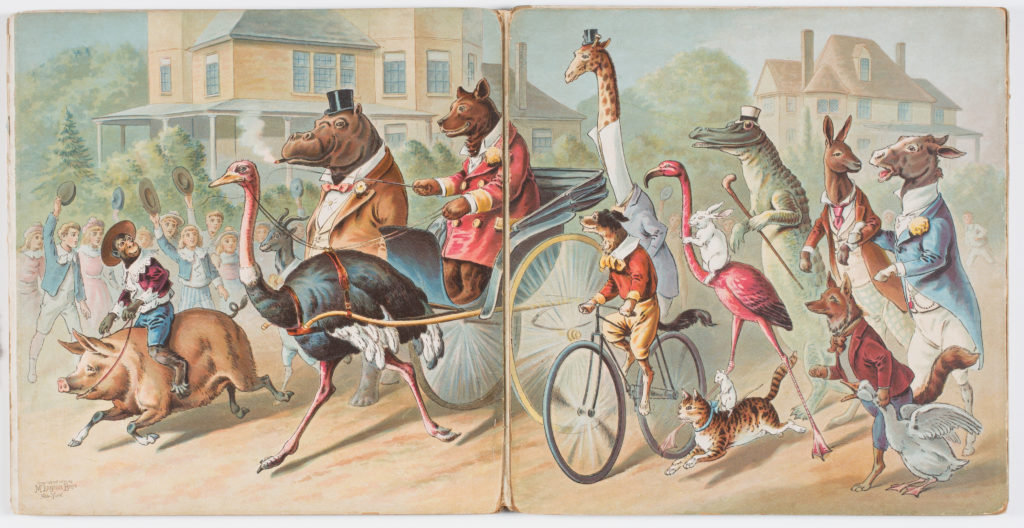
The exhibition Radiant with Color & Art: McLoughlin Brothers and the Business of Picture Books, 1858–1920, now on display at the Grolier Club in New York, is the culmination of my three decades’ worth of work in cataloging, documenting, and interpreting the output of this titan New York publisher that dominated color picture book publishing in the United States in the latter half of the nineteenth century. My contact with the some 1,800 McLoughlin picture books in the AAS Children’s Literature Collection began almost immediately after I joined the AAS staff in 1987. One of my first tasks as senior cataloger of the National Endowment for the Humanities-funded American Children’s Books project was to write the renewal proposal that would fund the cataloging of these color-filled treasures.
I quickly discovered that cataloging these books to rare book level would pose a variety of challenges, one of the biggest being that many of them did not have publication dates because they were meant to look eternally new, regardless of how long they might have sat in a warehouse before they were sold. I also realized that outside of a few brief essays in book dealers’ catalogs and periodicals, there was very little substantive information written about the history of McLoughlin Brothers because the firm’s business records did not survive. Furthermore, McLoughlin, unlike competitors such as E. P. Dutton or Frederick Warne, did not flourish after the early twentieth century, keeping it removed from modern memory. After the death of its co-founder and innovator-in-chief John McLoughlin Jr., McLoughlin Brothers was sold to Milton Bradley in 1920. The new owners reissued the hefty inventory of McLoughlin games under the Milton Bradley name and recast the picture books as the McLoughlin line of Milton Bradley. The McLoughlin line was sold off by Milton Bradley in the early 1950s, eventually becoming a brand used on a few books published by Grosset & Dunlap, until the legal demise of the McLoughlin corporate name in 1984.
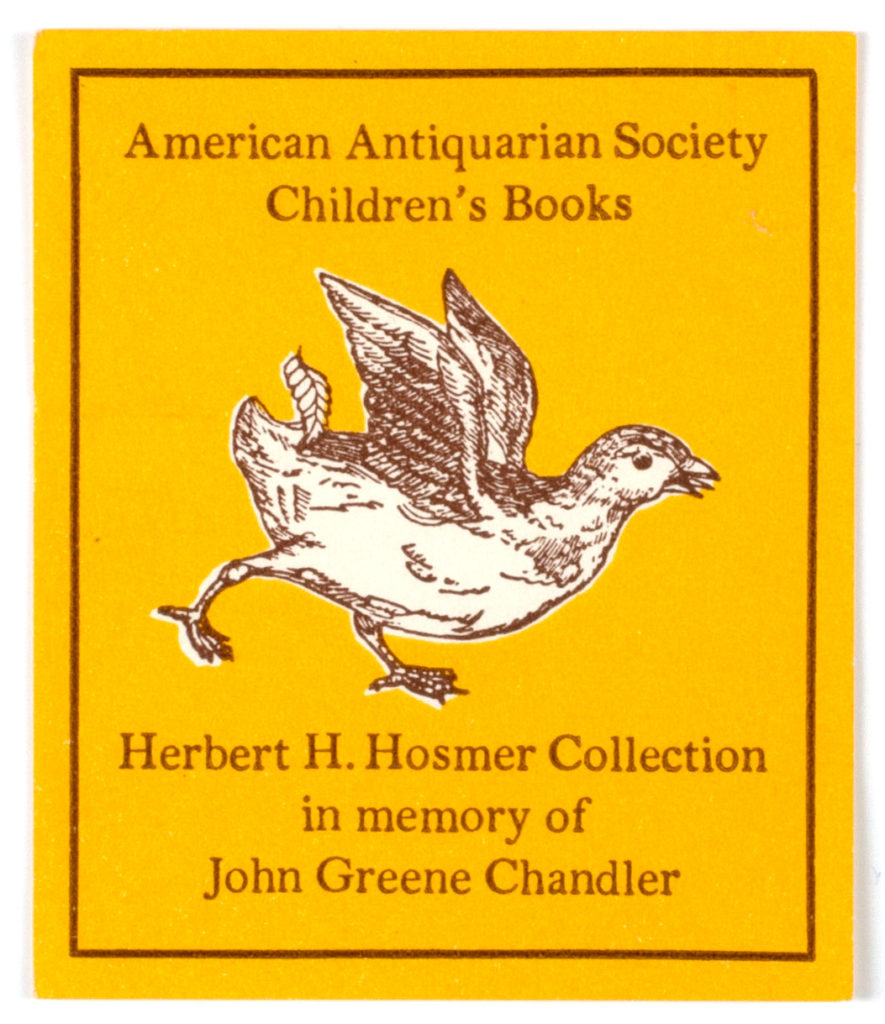
Due to these challenges, I acquired my knowledge of McLoughlin Brothers by cataloging the picture books themselves and by speaking to a few McLoughlin collectors, including Herbert Hosmer (1913–1995), who donated a large cache of books and artwork belonging to the McLoughlin business archives to AAS in 1978. Herbert was a charming eccentric, a schoolteacher who spent most of his career in the Lancaster, Massachusetts, public schools. A graduate of the Massachusetts College of Art, Herbert was a skilled puppeteer and the proprietor of the Toy Cupboard Theatre, which delighted generations of local children. His great uncle was John Greene Chandler (1815–1879), an engraver and lithographer who designed picture books and paper dolls. Chandler’s daughter Alice (referred to by Herbert as “Cousin Alice”) told young Herbert about her father’s career as a book illustrator in antebellum Boston, and she eventually gave him some of those picture books, thus planting the book collecting seed that became Herbert’s lifelong passion. By the 1960s, he was a serious collector of children’s books, dolls, and dollhouses.
Fortunately for AAS, Herbert was also a serious reader of newspaper obituaries, so when he read that Charles Ernest Miller (1869–1951), a longtime McLoughlin Brothers executive, had died, he eagerly contacted Miller’s surviving daughter, Ruth, to see if she had any McLoughlin Brothers books he could purchase. Miss Miller didn’t answer until many years later, but when she did Herbert was more than ready to examine what she had, which turned out to be over one thousand items, including picture books, games, paper toys, illustration blocks, and original artwork belonging to the McLoughlin business archives. Herbert arranged to buy the whole collection from Miss Miller on an installment plan. He made at least the first installment and took possession of the McLoughlin treasure trove, but his ambition as a collector was not matched by his salary as a public schoolteacher in the 1970s. Seeking a way to pay Miss Miller the money due her and keep the magnificent collection together, Herbert sought the help of then American Antiquarian Society President Marcus McCorison. Herbert had been an occasional researcher at AAS since about 1940, using AAS holdings to document the careers of his artist ancestors Winthrop Chandler and John Greene Chandler. When Marcus examined Herbert’s McLoughlin trove, he swiftly realized its importance in the history of the book in America; as a whole the archive reflects the profound changes in picture book production in the mid nineteenth century from poorly hand-colored wood engravings to sophisticated chromolithography done on steam-powered presses. McCorison paid Miss Miller the balance and made Herbert honorary curator of children’s literature. It was just when Herbert had retired from his honorary curatorship that I came to AAS and met him in 1987.
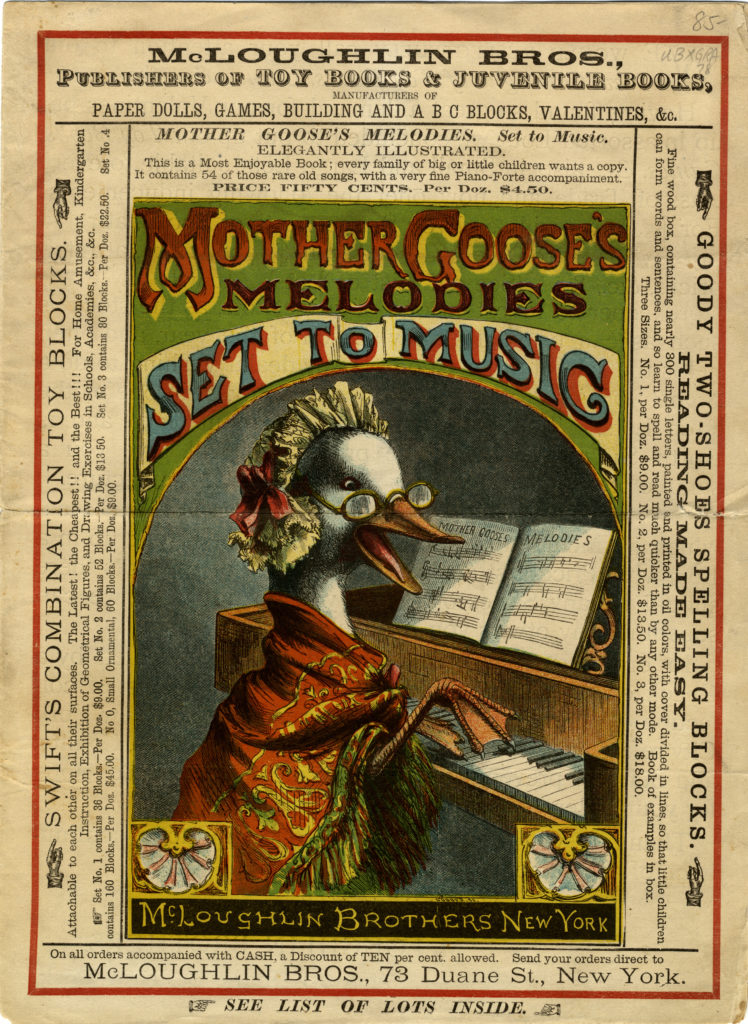
In unpredictable health and unable to drive, Herbert came to AAS occasionally during my early days at AAS, regaling me with tales of nineteenth-century publishers and his joy in collecting the books they had produced, as well as showing me his arrangement of the books and drawings awaiting substantive cataloging. Examining the neatly typed envelopes housing each of the fragile picture books, I soon came to recognize his curvaceous Palmer method handwritten notes on some of the envelopes, identifying illustrators, color printing processes, or estimated publication dates. These notes eventually informed my cataloging of these books. I can still hear his lively cadence when I read those notes. He urged me to phone him if I had any questions about the collection, of which I had many, particularly in my first few years at AAS. Talking to Herbert on the phone was always an adventure. I realized that he preferred to live in the past—not his personal past, but his extended family’s past in the eighteenth and nineteenth centuries! He would tell me of fantastic Fourth of July celebrations in mid-nineteenth-century Boston and the tragic ends of long-lost relatives and eventually cycle back to answering my question; regardless of whether I actually got an answer, the journey was splendid!
Thankfully, I had the Society’s premier collections to help answer my questions, including a nearly complete run of New York city directories to document the dates of activity of McLoughlin Brothers at specific addresses. Another crucial source was the McLoughlin publisher’s catalogs, which came to AAS as part of Herbert Hosmer’s donation. They linked specific titles to dates and showed how McLoughlin largely arranged its inventory within a complex system of series that were produced in an array of price points ranging from one cent to two dollars.
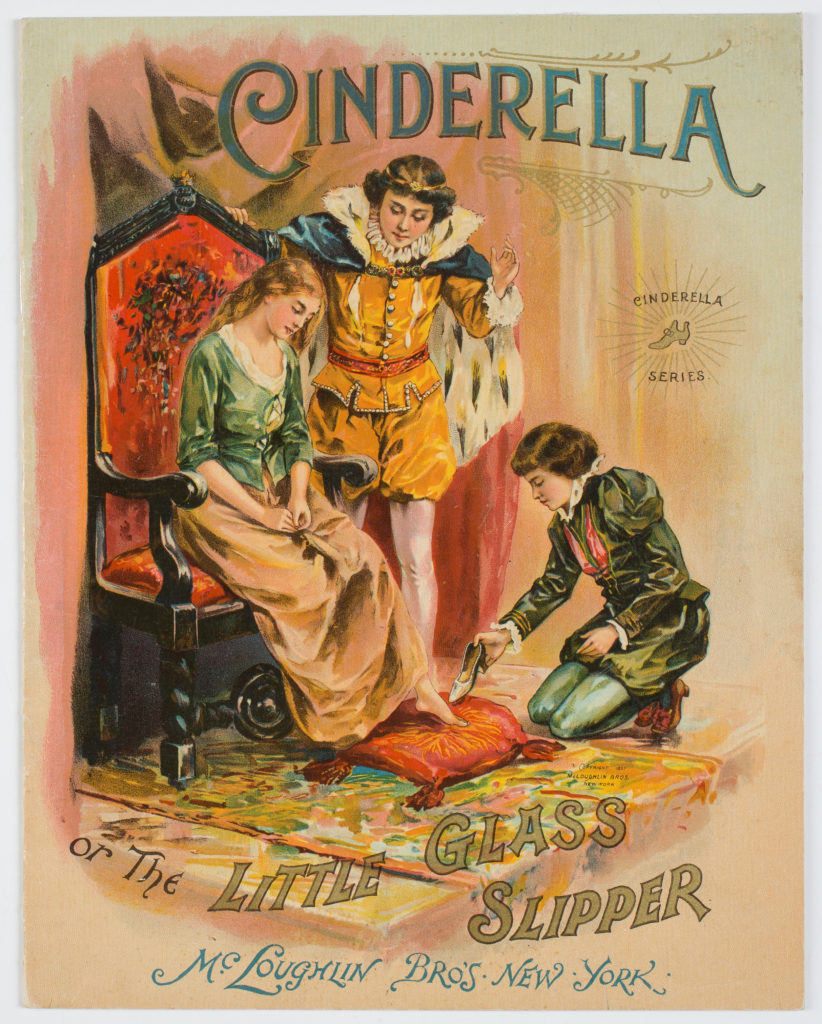
While cataloging the McLoughlin picture books I began to give conference presentations on my work, drumming up interest among scholars to come to AAS and use this fascinating visual material. AAS was way ahead of the curve in providing rare book-level access to historical children’s literature, and very few researchers coming to AAS in the 1980s and 1990s came to work specifically with children’s books. I had to both build the intellectual infrastructure and promote the material. While writing one conference presentation about the portrayal of the picture book Cinderella in nineteenth-century America, I discovered that this popular tale was produced by McLoughlin among a number of series simultaneously (including the Cinderella Series) and at a variety of price points. Cinderella also provided a key way into exploring developments in McLoughlin’s use of illustration technologies, from wood engraving to zinc etching and eventually chromolithography. I was learning to navigate the world of McLoughlin on a number of levels!
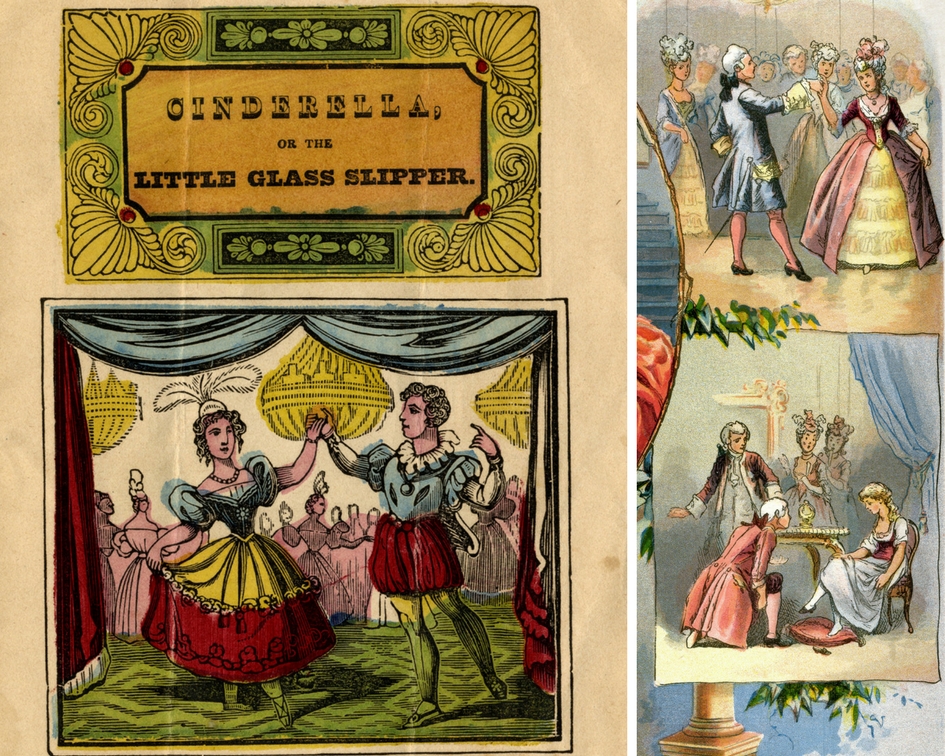
Enter AAS member George King Fox (1937–2017). Elected in 2005, George had a direct family connection to McLoughlin Brothers: both his father, George Marshall Fox, and his grandfather George Albert Fox worked as executives for the McLoughlin line of Milton Bradley. Having grown up in Springfield, Massachusetts, near the Milton Bradley plant, George King Fox moved west to California to pursue his passion of alpine skiing. He eventually convinced his father to move to San Francisco and donate his children’s book collection, which included many picture books from the McLoughlin business archives, to the San Francisco Public Library (SFPL). I met George King Fox shortly after his election to AAS membership, and we spoke briefly about our respective McLoughlin Brothers collections. Several years later I received a phone call from George inviting me to San Francisco to give a lecture on the history of McLoughlin Brothers in conjunction with the first major exhibition of his father’s collection at SFPL since its donation in 1978. I was given a magnificent opportunity to put together all the bits of information about McLoughlin that I had acquired over some twenty-five years of cataloging these picture books, and I embraced the assignment! Using my old friend Cinderella, I worked with my colleague AAS Curator of Graphic Arts Lauren Hewes to pinpoint when McLoughlin Brothers started to switch over from hand-coloring to machine-color printing, which turned out to be about 1867. Between my memory of how the picture books looked and Lauren’s technical expertise, we made a great discovery little documented in the history of illustration!
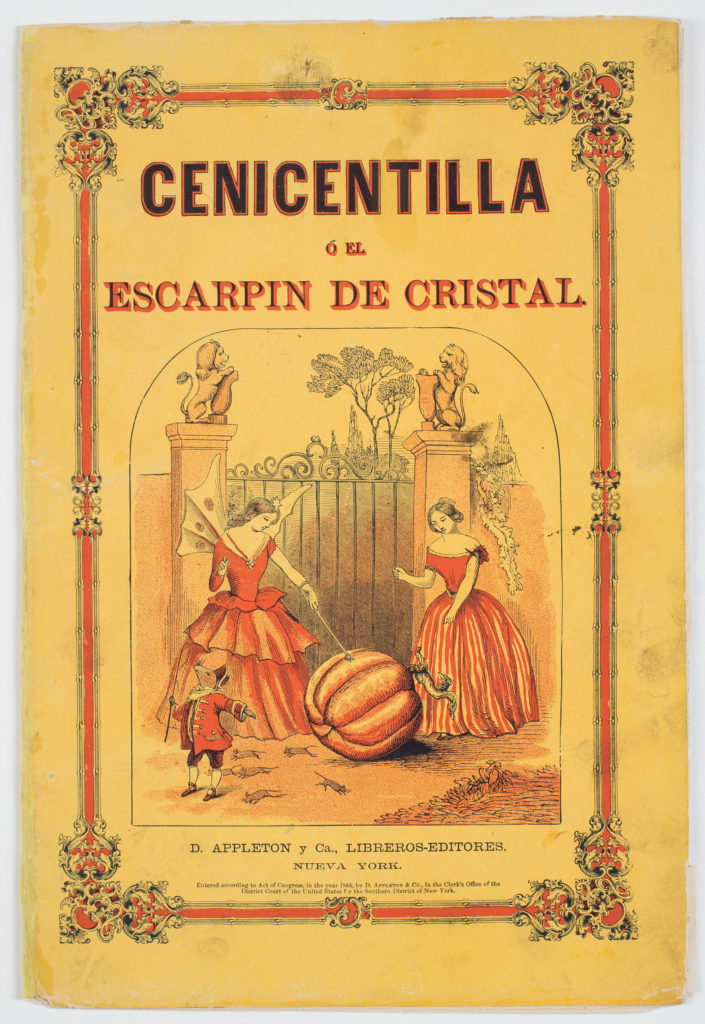
Once in San Francisco, I took a look at the George Marshall Fox Collection and realized that the collection contained material filling gaps in the AAS collection and that I needed to dig into it. Thanks to the hospitality of George and his partner, Dorothea Preus, I was able to return to San Francisco several more times to mine the riches of the Fox Collection, which is a wonderful resource. In the course of my research with the collection, I discovered that McLoughlin manufactured Spanish-language picture books for seeming rival D. Appleton & Company. The business records apparently don’t survive for either firm, so the only way of discovering the relationship was through examining the books themselves.
When Lauren Hewes and I were approached by members of the Grolier Club to submit a proposal for an exhibition on McLoughlin Brothers, we knew that we had the material and the knowledge to write on McLoughlin’s seminal place in the business of picture book publishing. I am absolutely thrilled that I was able to do the research and select the material that tells this long untold tale, and that this story is so beautifully documented in our exhibition catalog, Radiant with Color & Art: McLoughlin Brothers and the Business of Picture Books, 1858–1920. Like Cinderella, I got to go to the ball after many years of hard work. The exhibition will be on view at the Grolier Club (47 E. 60th St., New York) through February 3. Please consider coming to the public reception for the exhibition on Tuesday, January 23, at 2:30 p.m.

I have a copy of Giant Story Book that was my grandfather’s.
The cover and back are not attached but are present. The pages are in pretty good condition! My grandfather’s name is inside the front cover with the date 1898 stating that he was 8 years old. I would like to find someone who would like to own this, no charge. I just can’t throw it away but have no idea what to do with it. Progeny will not value it; I am 74 years old. On the cover, 3 girls in long dresses, mittens, and lovely head coverings are building a snowman. Would you like it?